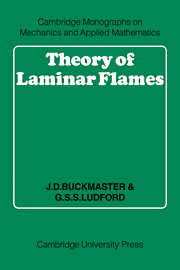Book contents
- Frontmatter
- Contents
- Preface
- 1 Governing equations of combustion
- 2 The premixed plane flame
- 3 Perturbations: SVFs and NEFs
- 4 Steady burning of a linear condensate
- 5 Unsteady burning of a linear condensate
- 6 Spherical diffusion flames
- 7 Cylindrical and spherical premixed flames
- 8 Multidimensional theory of premixed flames
- 9 Burners
- 10 Effects of shear and strain
- 11 Stability
- 12 Ignition and explosion
- Text references
- Further references
- Citation Index
- Subject Index
1 - Governing equations of combustion
Published online by Cambridge University Press: 05 May 2010
- Frontmatter
- Contents
- Preface
- 1 Governing equations of combustion
- 2 The premixed plane flame
- 3 Perturbations: SVFs and NEFs
- 4 Steady burning of a linear condensate
- 5 Unsteady burning of a linear condensate
- 6 Spherical diffusion flames
- 7 Cylindrical and spherical premixed flames
- 8 Multidimensional theory of premixed flames
- 9 Burners
- 10 Effects of shear and strain
- 11 Stability
- 12 Ignition and explosion
- Text references
- Further references
- Citation Index
- Subject Index
Summary
Approach
The development of the equations governing combustion involves derivation of the equations of motion of a chemically reacting gaseous mixture and judicious simplification to render them tractable while retaining their essential characteristics. A rigorous derivation requires a long apprenticeship in either kinetic theory or continuum mechanics. (Indeed, the general continuum theory of reacting mixtures is only now being perfected.) We choose instead a plausible, but potentially rigorous, derivation based on the continuum theory of a mixture of fluids, guided by experience with a single fluid. Ad hoc arguments, in particular the inconsistent assumption that the mixture itself is a fluid for the purpose of introducing certain constitutive relations, will not be used.
Treating the flow of a reacting mixture as an essentially isobaric process, the so-called combustion approximation, is a safe simplification under a wide range of circumstances if detonations are excluded. But the remaining simplifications, designed as they are solely to make the equations tractable, should be accepted tentatively. They are always revocable should faulty predictions result; for that reason they are explained carefully. Nevertheless, whosoever is primarily interested in solving nontrivial combustion problems, as we are, can have the same confidence in the final equations as is normally placed in the equations of a non-Newtonian fluid, for example.
- Type
- Chapter
- Information
- Theory of Laminar Flames , pp. 1 - 19Publisher: Cambridge University PressPrint publication year: 1982



